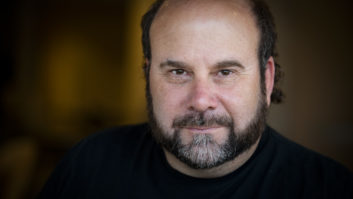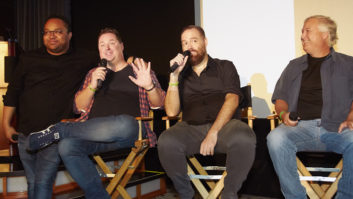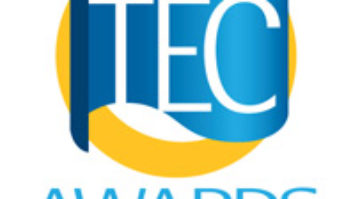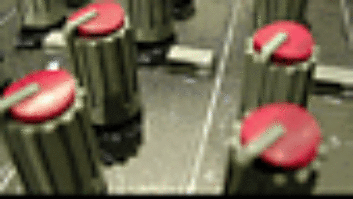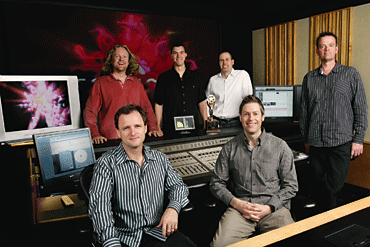
There are many great houses of game audio production that deserve attention, and in due course I’ll cover all of them. The first of these has the gusto to include “interactive” as part of its name: Technicolor Interactive — the same Technicolor you’ve come to know and love at the end of movie credits for film color processing. (It was the second company to use it way back in the 1920s.)
The Technicolor Interactive team. Front, from left: Lydian Tone, sound designer/supervisor; Mark Jasper, sound designer/re-recording mixer; and Tom Hays, director of audio services. Rear, from left: Mark Lewer, technical engineer; Morgan Gerhard, ADR recordist; and Michael Gollom, VP interactive services. Not pictured: sound designer Frank Szick and assistants David Fisk and Jake Worthington.
Photos: Jim Gentry
Nestled in downtown Burbank, Calif., Technicolor has created a great new set of studios that you might think would be used exclusively for film and television. But while its voice-over studios provide recording and editing services for gaming’s linear cousins, Technicolor Interactive provides voice-over, sound effects and music for games, along with a complete set of services ranging from user interface design to art to localization, and, of course, all manner of audio assets.
Michael Gollom started Technicolor Interactive in 2005 after having racked up significant credits working on such titles as Spyro, Jack and Daxter and Crash Bandicoot, and after a short two years, he has rounded up some of the biggest names in the industry to work on top-notch games. This house is busy!
Technicolor had already provided a good chunk of sound effects for the original hit God of War. “We’re currently doing in-game creatures and weapon sounds for Hellgate London,” says audio director Tom Hays. “We did the voice casting and recording for Gears of War with Chris Borders directing; our animators also did a phenomenal job on their work on the cinematics. On Legend of Spyro, we did the casting and recording and handed the voice tracks to our animators. They then created cinematics from the ground up and handed the scenes back to us for complete audio post and mix.
“We just finished about 40 days of ADR for a Japanese Xbox 360 title called Blue Dragon, created by the gentleman who made Final Fantasy,” he continues. We also did all of the voice editing and supplied the director for casting and recording. We’ve done casting and recording on a bunch of games, some of them very large, such as Scarface, Jade Empire and Mass Effect.”
Remember those key words “integration” and “real-time mixing”? Technicolor is jumping in with both feet, with all its rooms set up for work in Wwise, FMOD, SCREAM (a Sony audio tool) and XACT, and being asked to create sound banks for studios, not just deliver a batch of WAVs, AIFFs or OMFs. Just as predicted, big publishers and studios are seeing the value of a post-production cycle at the end of development, and in the interest of contiguous post engineering, it doesn’t hurt that all of these rooms have calibrated surround monitoring and metering.
“We have three ADR stages of various sizes,” Hays says. “Our mic of choice is usually a Neumann TLM 103, a very precise mic that matches well with our Avalon VT-737SP tube preamps. Naturally, we have other standard mics on hand such as Sennheiser 416s and [Neumann] U87s. For mixers, we’re running the Yamaha 02R96, which we connect digitally into Pro Tools. Our video is all Quicktime-based, using Black Magic Decklink cards, though we do have Technicolor rooms down the street with pretty much every video deck imaginable.
“We’ve also been using Source Connect, which lets clients with a Pro Tools system and a good Internet connection have real-time, two-way communication with our studio at MP3 quality, just like ISDN. This is important for game developers since so many of them are in locations far away from L.A.’s voice talent pool. For actor facial capture, we use an Avid Mojo, and we have a home-brewed teleprompter system when the talent needs to look directly into the camera.
“Our three main edit rooms and the mix room are all equipped with Pro Tools HD3, mostly on G5s, with a good set of sound design tools and plug-ins,” Hays says. “We went with JBLs, though we have some Blue Sky systems, as well.” The edit rooms are all 5.1, with LSR 4328s in front, LSR 4326s for surrounds and 4312 subs. The ProControl-based mix room has 6332s in front and a 6212 sub, and is wired up for 7.1 surround with 4326s. System controllers are StudioComm 69As and Tascam DSM-7.1s. For video in the mix room, there is an InFocus IN76 video projector.
The building is wired for gigabit Ethernet, as is the connection to the outside world. The facility has about 10 TB of space in a SAN. Game editors and mixers also have access to a sound effects server at Technicolor Theatrical Services — which includes the former Weddington Sound — with close to 2 TB of material.
In the case of licensed properties, Technicolor is in a unique position. Because it has a very active role in film duplication, it can provide localization services that can use the same actors in, say, the French version of Happy Feet as were used in the film. Hays initially worked with Technicolor when supervising the Spider-Man 2 videogame at Treyarch. “I came over here to finish and mix the cut scenes, and was impressed enough that I joined the team when the opportunity came along.”

ADR 1, one of Technicolor’s three voice recording stages, featuring a Yamaha 02R96 board, a pair of Avalon VT-737SP preamps and a custom teleprompter in the spacious booth. The three main edit rooms and mix room are all equipped with Pro Tools HD3.
Hays is passionate about more streamlined tools and uses engineers as much as possible to get there. “We have a technical staff to help with things like client game engines and complex secure connections,” Hays says. “Also, those of us who’ve spent years at game companies know how to deal with a good bit of this solo.”
Another advantage Technicolor has is its worldwide reach. With a total of five stages in Burbank, in addition to stages in Hollywood, Rome, London, Canada and Thailand, three to five ongoing voice projects in a single building is commonplace. “We’re set up to do a large volume of great work,” Hays says.
Technicolor is the only film studio I know of to dedicate a bona fide arm toward games. Combine that with the company’s roster of talent, experience with major feature films and studios set up to record voice-over worldwide, as well as its non-audio related services, and you can’t help but be impressed.
Alexander Brandon is the audio director at Obsidian Entertainment (Santa Ana, Calif.).
